A Modeling Approach to Diagnose the Impacts of Global Changes on Discharge and Suspended Sediment Concentration within the Red River Basin
Abstract
:1. Introduction
2. Materials and Methods
2.1. Study Area
2.1.1. General Characteristics
2.1.2. Meteorological and Hydrological General Characteristics
2.2. Modeling Approach
2.2.1. The SWAT Model
2.2.2. Hydrological Modeling Component in SWAT
2.2.3. Suspended Sediment Modeling Component in SWAT
2.3. SWAT Data Inputs
2.3.1. Topography, Land Use and Soil
2.3.2. Meteorological Data
2.3.3. Dam Implementations
2.4. Model Set Up
2.5. Calibration and Validation Process
2.6. Model Evaluation
2.6.1. The Coefficient of Determination (R2)
2.6.2. The Nash–Sutcliffe Efficiency (NSE)
2.6.3. The Percent Bias (PBIAS)
3. Results
3.1. Q Simulation and Hydrological Assessment
3.1.1. Hydrological Parameters
3.1.2. Q simulations
3.2. SSC Simulation
3.2.1. Calibration of SSC
3.2.2. SSC Simulations
3.3. Impacts of Climate Variability and Dams
3.3.1. Impacts on Q
3.3.2. Impacts on SSC
4. Discussion
4.1. Uncertainties
4.1.1. Uncertainties of Hydrology Modeling
4.1.2. Uncertainties of Suspended Sediment Modeling
4.2. Water Balance and Yield
4.3. Natural Conditions Effects
4.4. Impacts of Dams
5. Conclusions
Author Contributions
Funding
Acknowledgments
Conflicts of Interest
References
- Mekonnen, M.M.; Hoekstra, A.Y. Four billion people facing severe water scarcity. Sci. Adv. 2016, 2, e1500323. [Google Scholar] [CrossRef] [PubMed]
- Global Risks 2015, 10th ed.; World Economic Forum: Geneva, Switzerland, 2015.
- Kunz, M.J.; Wüest, A.; Wehrli, B.; Landert, J.; Senn, D.B. Impact of a large tropical reservoir on riverine transport of sediment, carbon, and nutrients to downstream wetlands. Water Resour. Res. 2011, 47, W12531. [Google Scholar] [CrossRef]
- Lal, R.; Kimble, J.; Levine, E.; Stewart, B.A. Soils and Global Change; CRC Press: Boca Raton, FL, USA, 1995. [Google Scholar]
- Nijssen, B.; O’donnell, G.M.; Hamlet, A.F.; Lettenmaier, D.P. Hydrologic sensitivity of global rivers to climate change. Clim. Chang. 2001, 50, 143–175. [Google Scholar] [CrossRef]
- Arnell, N.W. Climate change and global water resources. Glob. Environ. Chang. 1999, 9, S31–S49. [Google Scholar] [CrossRef]
- Thi Ha, D.; Ouillon, S.; Van Vinh, G. Water and Suspended Sediment Budgets in the Lower Mekong from High-Frequency Measurements (2009–2016). Water 2018, 10, 846. [Google Scholar] [CrossRef]
- Watson, R.T.; Noble, I.R.; Bolin, B.; Ravindranath, N.H.; Verardo, D.J.; Dokken, D.J. The Intergovernmental Panel on Climate Change (IPCC) Special Report on Land Use, Land-Use Change, and Forestry; Cambridge University Press: Cambridge, UK, 2000. [Google Scholar]
- FAO. The State of the World’s Land and Water Resources for Food and Agriculture (SOLAW)—Managing Systems at Risk; The Food and Agriculture Organization of the United Nations: Abingdon, UK; Earthscan: New York, NY, USA, 2011; ISBN 9781849713269. [Google Scholar]
- Valentin, C.; Agus, F.; Alamban, R.; Boosaner, A.; Bricquet, J.P.; Chaplot, V.; de Guzman, T.; de Rouw, A.; Janeau, J.L.; Orange, D.; et al. Runoff and sediment losses from 27 upland catchments in Southeast Asia: Impact of rapid land use changes and conservation practices. Agric. Ecosyst. Environ. 2008, 128, 225–238. [Google Scholar] [CrossRef]
- Chen, J.; Shi, H.; Sivakumar, B.; Peart, M.R. Population, water, food, energy and dams. Renew. Sustain. Energy Rev. 2016, 56, 18–28. [Google Scholar] [CrossRef]
- Zimmerman, J.B.; Mihelcic, J.R.; Smith, J. Global Stressors on Water Quality and Quantity. Environ. Sci. Technol. 2008, 42, 4247–4254. [Google Scholar] [CrossRef] [PubMed]
- Hecht, J.S.; Lacombe, G.; Arias, M.E.; Dang, T.D.; Piman, T. Hydropower dams of the Mekong River basin: A review of their hydrological impacts. J. Hydrol. 2019, 568, 285–300. [Google Scholar] [CrossRef]
- Dams and Development: A New Framework for Decision-Making; The World Commission on Dams: London UK, 2000.
- Lehner, B.; Liermann, C.R.; Revenga, C.; Vörösmarty, C.; Fekete, B.; Crouzet, P.; Döll, P.; Endejan, M.; Frenken, K.; Magome, J.; et al. High-resolution mapping of the world’s reservoirs and dams for sustainable river-flow management. Front. Ecol. Environ. 2011, 9, 494–502. [Google Scholar] [CrossRef]
- Zarfl, C.; Lumsdon, A.E.; Berlekamp, J.; Tydecks, L.; Tockner, K. A global boom in hydropower dam construction. Aquat. Sci. 2015, 77, 161–170. [Google Scholar] [CrossRef]
- Van Manh, N.; Dung, N.V.; Hung, N.N.; Kummu, M.; Merz, B.; Apel, H. Future sediment dynamics in the Mekong Delta floodplains: Impacts of hydropower development, climate change and sea level rise. Glob. Planet. Chang. 2015, 127, 22–33. [Google Scholar] [CrossRef]
- Vörösmarty, C.J.; Meybeck, M.; Fekete, B.; Sharma, K.; Green, P.; Syvitski, J.P.M. Anthropogenic sediment retention: Major global impact from registered river impoundments. Glob. Planet. Chang. 2003, 39, 169–190. [Google Scholar] [CrossRef]
- Syvitski, J.P.M.; Vörösmarty, C.J.; Kettner, A.J.; Green, P. Impact of humans on the flux of terrestrial sediment to the global coastal ocean. Science 2005, 308, 376–380. [Google Scholar] [CrossRef]
- Syvitski, J.P.; Morehead, M.D.; Bahr, D.B.; Mulder, T. Estimating fluvial sediment transport: The rating parameters. Water Resour. Res. 2000, 36, 2747–2760. [Google Scholar] [CrossRef]
- Zhang, S.; Chen, D.; Li, F.; He, L.; Yan, M.; Yan, Y. Evaluating spatial variation of suspended sediment ratingcurves in the middle Yellow River basin, China. Hydrol. Process. 2018, 32, 1616–1624. [Google Scholar] [CrossRef]
- Asselman, N.E. Fitting and interpretation of sediment rating curves. J. Hydrol. 2000, 234, 228–248. [Google Scholar] [CrossRef]
- Achite, M.; Ouillon, S. Suspended sediment transport in a semiarid watershed, Wadi Abd, Algeria (1973–1995). J. Hydrol. 2007, 343, 187–202. [Google Scholar] [CrossRef]
- Daniel, E.B.; Camp, J.V.; LeBoeuf, E.J.; Penrod, J.R.; Dobbins, J.P.; Abkowitz, M.D. Watershed Modeling and its Applications: A State-of-the-Art Review. Open Hydrol. J. 2011, 5, 26–50. [Google Scholar] [CrossRef]
- Islam, Z. A Review on Physically Based Hydrologic Modeling; University of Alberta: Edmonton, AB, Canada, 2011; Available online: https://www.researchgate.net/publication/272169378_A_Review_on_Physically_Based_Hydrologic_Modeling (accessed on 3 May 2019).
- Devia, G.K.; Ganasri, B.P.; Dwarakish, G.S. A Review on Hydrological Models. Aquat. Procedia 2015, 4, 1001–1007. [Google Scholar] [CrossRef]
- Fu, B.; Merritt, W.S.; Croke, B.F.W.; Weber, T.R.; Jakeman, A.J. A review of catchment-scale water quality and erosion models and a synthesis of future prospects. Environ. Model. Softw. 2019, 114, 75–97. [Google Scholar] [CrossRef]
- Graham, D.N.; Butts, M.B. Flexible, Integrated Watershed Modelling with MIKE SHE in Watershed Models. In Watershed Models; Singh, V.P., Frevert, D.K., Eds.; CRC Press: Boca Raton, FL, USA, 2005; ISBN 0849336090. [Google Scholar]
- Bicknell, B.R.; Imhoff, J.C.; Kittle, J.L.J.; Anthony, S.; Donigian, J.; Johanson, R.C. Hydrological Simulation Program—Frotran: User ’ s Manual for Version 11; AQUA TERRA Consultants: Mountain View, CA, USA, 1997. [Google Scholar]
- Arnold, J.G.; Srinivasan, R.; Muttiah, R.S.; Williams, J.R. Large area hydrologic modeling and assesment Part I: Model development. JAWRA J. Am. Water Resour. Assoc. 1998, 34, 73–89. [Google Scholar] [CrossRef]
- Gassman, P.W.; Reyes, M.R.; Green, C.H.; Arnold, J.G. The Soil and Water Assessment Tool: Historical development, applications, and future research directions. Trans. ASAE 2007, 50, 1211–1250. [Google Scholar] [CrossRef]
- Bannwarth, M.A.; Hugenschmidt, C.; Sangchan, W.; Lamers, M.; Ingwersen, J.; Ziegler, A.D.; Streck, T. Simulation of Stream Flow Components in a Mountainous Catchment in Northern Thailand with SWAT, Using the ANSELM Calibration Approach. Hydrol. Processes 2015, 29, 1340–1352. [Google Scholar] [CrossRef]
- Lweendo, M.K.; Lu, B.; Wang, M.; Zhang, H.; Xu, W. Characterization of droughts in humid subtropical region, upper kafue river basin (Southern Africa). Water 2017, 9, 242. [Google Scholar] [CrossRef]
- Li, D.; Christakos, G.; Ding, X.; Wu, J. Adequacy of TRMM satellite rainfall data in driving the SWAT modeling of Tiaoxi catchment (Taihu lake basin, China). J. Hydrol. 2018, 556, 1139–1152. [Google Scholar] [CrossRef]
- Shrestha, B.; Cochrane, T.A.; Caruso, B.S.; Arias, M.E. Land use change uncertainty impacts on streamflow and sediment projections in areas undergoing rapid development: A case study in the Mekong Basin. Land Degrad. Dev. 2018, 29, 835–848. [Google Scholar] [CrossRef]
- Van Thiet, N.; Didier, O.; Dominique, L.; Van Cu, P. Consequences of large hydropower dams on erosion budget within hilly agricultural catchments in Northern Vietnam by RUSLE modeling. In Proceedings of the International Conference Sediment Transport Modeling in Hydrological Watersheds and Rivers, Istanbul, Turkey, 14–16 November 2012; p. 8. [Google Scholar]
- Le, T.P.Q.; Garnier, J.; Gilles, B.; Sylvain, T.; Van Minh, C. The changing flow regime and sediment load of the Red River, Viet Nam. J. Hydrol. 2007, 334, 199–214. [Google Scholar] [CrossRef]
- He, D.; Ren, J.; Fu, K.; Li, Y. Sediment change under climate changes and human activities in the Yuanjiang-Red River Basin. Chinese Sci. Bull. 2007, 52, 164–171. [Google Scholar] [CrossRef]
- Dang, T.H.; Coynel, A.; Orange, D.; Blanc, G.; Etcheber, H.; Le, L.A. Long-term monitoring (1960–2008) of the river-sediment transport in the Red River Watershed (Vietnam): Temporal variability and dam-reservoir impact. Sci. Total Environ. 2010, 408, 4654–4664. [Google Scholar] [CrossRef]
- Lu, X.X.; Oeurng, C.; Le, T.P.Q.; Thuy, D.T. Sediment budget as affected by construction of a sequence of dams in the lower Red River, Viet Nam. Geomorphology 2015, 248, 125–133. [Google Scholar] [CrossRef]
- Le, T.P.Q.; Dao, V.N.; Rochelle-Newall, E.; Garnier, J.; Lu, X.; Billen, G.; Duong, T.T.; Ho, C.T.; Etcheber, H.; Nguyen, T.M.H.; et al. Total organic carbon fluxes of the Red River system (Vietnam). Earth Surf. Processes Landf. 2017, 42, 1329–1341. [Google Scholar] [CrossRef]
- Ngo, T.S.; Nguyen, D.B.; Rajendra, P.S. Effect of land use change on runoff and sediment yield in Da River Basin of Hoa Binh province, Northwest Vietnam. J. Mt. Sci. 2015, 12, 1051–1064. [Google Scholar] [CrossRef]
- Vinh, V.D.; Ouillon, S.; Thanh, T.D.; Chu, L.V. Impact of the Hoa Binh dam (Vietnam) on water and sediment budgets in the Red River basin and delta. Hydrol. Earth Syst. Sci. 2014, 18, 3987–4005. [Google Scholar] [CrossRef]
- Luu, T.N.M.; Garnier, J.; Billen, G.; Orange, D.; Némery, J.; Le, T.P.Q.; Tran, H.T.; Le, L.A. Hydrological regime and water budget of the Red River Delta (Northern Vietnam). J. Asian Earth Sci. 2010, 37, 219–228. [Google Scholar] [CrossRef]
- Hiep, N.H.; Luong, N.D.; Viet Nga, T.T.; Hieu, B.T.; Thuy Ha, U.T.; Du Duong, B.; Long, V.D.; Hossain, F.; Lee, H. Hydrological model using ground- and satellite-based data for river flow simulation towards supporting water resource management in the Red River Basin, Vietnam. J. Environ. Manag. 2018, 217, 346–355. [Google Scholar] [CrossRef]
- Zhu, Y.; Chen, C.; Jiang, H. Preliminary study on water resources protection in the Yuanjiang dry-hot valley of the Honghe river basin. Pearl River 2012, 1, 15–17. (In Chinese) [Google Scholar] [CrossRef]
- Zhang, W.; Zhao, Z.; Tan, S.; Li, Y.; Wang, A. Study on the soil erosion in the Yuanjiang–Honghe boundary river areas. Geol. Surv. China 2017, 4, 64–69. (In Chinese) [Google Scholar] [CrossRef]
- Bai, Z.; Feng, D.; Ding, J.; Duan, X. A study on the variations of soil physico-chemical properties and its environmental impactfactors in the Red River watershed. Yunnan Geogr. Environ. Res. 2015, 27, 81–90. (In Chinese) [Google Scholar] [CrossRef]
- Barton, A.P.; Fullen, M.A.; Mitchell, D.J.; Hocking, T.J.; Liu, L.; Wu Bo, Z.; Zheng, Y.; Xia, Z.Y. Effects of soil conservation measures on erosion rates and crop productivity on subtropical Ultisols in Yunnan Province, China. Agric. Ecosyst. Environ. 2004, 104, 343–357. [Google Scholar] [CrossRef]
- Le, T.P.Q. Biogeochemical Functioning of the Red River (North Vietnam): Budgets and Modelling. Ph.D. Thesis, Université Paris VI-Pierre et Marie Curie, Paris, France, 2005. [Google Scholar]
- Li, X.; Li, Y.; He, J.; Luo, X. Analysis of variation in runoff and impacts factors in the Yuanjiang-Red River Basin from 1956 to 2013. Resour. Sci. 2016, 38, 1149–1159. (In Chinese) [Google Scholar] [CrossRef]
- Xie, S. The Hydrological Characteristics of the Red River Basin. Hydrology 2002, 22, 57–63. (In Chinese) [Google Scholar] [CrossRef]
- Li, Y.; He, D.; Ye, C. Spatial and temporal variation of runoff of red river basin in yunnan. J. Geogr. Sci. 2008, 18, 308–318. [Google Scholar] [CrossRef]
- Simons, G.; Bastiaanssen, W.; Ngô, L.; Hain, C.; Anderson, M.; Senay, G. Integrating Global Satellite-Derived Data Products as a Pre-Analysis for Hydrological Modelling Studies: A Case Study for the Red River Basin. Remote Sens. 2016, 8, 279. [Google Scholar] [CrossRef]
- Frenken, K. Irrigation in Southern and Eastern Asia in Figures; FAO: Rome, Italy, 2011. [Google Scholar]
- Ren, J.; He, D.; Fu, K.; Li, Y. Sediment variation in the Yuanjiang (the Red River Basin) driven by climate change and human activities. Chin. Sci. Bull. 2007, 52, 142–147. (In Chinese) [Google Scholar] [CrossRef]
- Neitsch, S.; Arnold, J.; Kiniry, J.; Williams, J. Soil and Water Assessment Tool Theoretical Documentation Version 2009; Texas Water Resources Institute Technical Report No. 406; Texas A&M University System: College Station, TX, USA, 2009. [Google Scholar]
- Giang, P.Q.; Toshiki, K.; Sakata, M.; Kunikane, S.; Vinh, T.Q. Modelling climate change impacts on the seasonality of water resources in the upper Ca river watershed in Southeast Asia. Sci. World J. 2014, 2014. [Google Scholar] [CrossRef] [PubMed]
- Ma, C.; Sun, L.; Liu, S.; Shao, M.; Luo, Y. Impact of climate change on the streamflow in the glacierized Chu River Basin, Central Asia. J. Arid Land 2015, 7, 501–513. [Google Scholar] [CrossRef]
- Piman, T.; Cochrane, T.A.; Arias, M.E.; Green, A.; Dat, N.D. Assessment of Flow Changes from Hydropower Development and Operations in Sekong, Sesan, and Srepok Rivers of the Mekong Basin. J. Water Resour. Plan. Manag. 2013, 139, 723–732. [Google Scholar] [CrossRef]
- Bannwarth, M.A.; Sangchan, W.; Hugenschmidt, C.; Lamers, M.; Ingwersen, J.; Ziegler, A.D.; Streck, T. Pesticide transport simulation in a tropical catchment by SWAT. Environ. Pollut. 2014, 191, 70–79. [Google Scholar] [CrossRef]
- de Silva, V.P.R.; Silva, M.T.; Singh, V.P.; de Souza, E.P.; Braga, C.C.; de Holanda, R.M.; Almeida, R.S.R.; de Sousa, F.A.S.; Braga, A.C.R. Simulation of stream flow and hydrological response to land-cover changes in a tropical river basin. Catena 2018, 162, 166–176. [Google Scholar] [CrossRef]
- da Silva, R.M.; Dantas, J.C.; Beltrão, J.A.; Santos, C.A.G. Hydrological simulation in a tropical humid basin in the Cerrado biome using the SWAT model. Hydrol. Res. 2018, 49, 908–923. [Google Scholar] [CrossRef]
- Fukunaga, D.C.; Cecílio, R.A.; Zanetti, S.S.; Oliveira, L.T.; Caiado, M.A.C. Application of the SWAT hydrologic model to a tropical watershed at Brazil. Catena 2015, 125, 206–213. [Google Scholar] [CrossRef]
- Marhaento, H.; Booij, M.J.; Hoekstra, A.Y. Hydrological response to future land-use change and climate change in a tropical catchment. Hydrol. Sci. J. 2018, 63, 1368–1385. [Google Scholar] [CrossRef]
- Yaduvanshi, A.; Sharma, R.K.; Kar, S.C.; Sinha, A.K. Rainfall–runoff simulations of extreme monsoon rainfall events in a tropical river basin of India. Nat. Hazards 2018, 90, 843–861. [Google Scholar] [CrossRef]
- Piman, T.; Cochrane, T.A.; Arias, M.E. Effect of Proposed Large Dams on Water Flows and Hydropower Production in the Sekong, Sesan and Srepok Rivers of the Mekong Basin. River Res. Appl. 2016, 32, 2095–2108. [Google Scholar] [CrossRef]
- Vu, M.T.; Raghavan, S.V.; Liong, S.Y. SWAT use of gridded observations for simulating runoff—A Vietnam river basin study. Hydrol. Earth Syst. Sci. 2012, 16, 2801–2811. [Google Scholar] [CrossRef]
- Ha, L.T.; Bastiaanssen, W.G.M.; van Griensven, A.; van Dijk, A.I.J.M.; Senay, G.B. Calibration of spatially distributed hydrological processes and model parameters in SWAT using remote sensing data and an auto-calibration procedure: A case study in a Vietnamese river basin. Water 2018, 10, 212. [Google Scholar] [CrossRef]
- Nguyen-Tien, V.; Elliott, R.J.R.; Strobl, E.A. Hydropower generation, flood control and dam cascades: A national assessment for Vietnam. J. Hydrol. 2018, 560, 109–126. [Google Scholar] [CrossRef]
- Le, T.; Sharif, H. Modeling the Projected Changes of River Flow in Central Vietnam under Different Climate Change Scenarios. Water 2015, 7, 3579–3598. [Google Scholar] [CrossRef]
- National Engineering Handbook-Part 630 Hydrology, Chapter 4–10; USDA Soil Conservation Service: Washington, DC, USA, 1972.
- Williams, J.R. Flood Routing With Variable Travel Time or Variable Storage Coefficients. Trans. ASAE 1969, 12, 0100–0103. [Google Scholar] [CrossRef]
- Cunge, J.A. On the subject of a flood propagation computation method (Musklngum method). J. Hydraul. Res. 1969, 7, 205–230. [Google Scholar] [CrossRef]
- Hargreaves, G.L.; Hargreaves, G.H.; Riley, J.P. Agricultural Benefits for Senegal River Basin. J. Irrig. Drain. Eng. 1985, 111, 113–124. [Google Scholar] [CrossRef]
- Williams, J.R. Sediment Routing for Agricultural Watersheds. JAWRA J. Am. Water Resour. Assoc. 1975, 11, 965–974. [Google Scholar] [CrossRef]
- Bagnold, R.A. Bed load transport by natural rivers. Water Resour. Res. 1977, 13, 303–312. [Google Scholar] [CrossRef]
- FAO-Unesco Soil Map of the World-Sotheast Asia; FAO-Unesco: Paris, France, 1979; Volume IX.
- Dao, N. Dam development in Vietnam: The evolution of dam-induced resettlement policy. Water Altern. 2010, 3, 324–340. [Google Scholar]
- Abbaspour, K.C. SWAT-CUP: SWAT Calibration and Uncertainty Programs—A User Manual; Eawag: Dübendorf, Switzerland, 2015; Available online: https://swat.tamu.edu/media/114860/usermanual_swatcup.pdf (accessed on 3 May 2019).
- Arnold, J.G.; Moriasi, D.N.; Gassman, P.W.; Abbaspour, K.C.; White, M.J.; Srinivasan, R.; Santhi, C.; Harmel, R.D.; van Griensven, A.; Van Liew, M.W.; et al. SWAT: Model Use, Calibration, and Validation. Trans. ASABE 2012, 55, 1491–1508. [Google Scholar] [CrossRef]
- Yang, J.; Reichert, P.; Abbaspour, K.C.; Xia, J.; Yang, H. Comparing uncertainty analysis techniques for a SWAT application to the Chaohe Basin in China. J. Hydrol. 2008, 358, 1–23. [Google Scholar] [CrossRef]
- Le, T.P.Q.; Seidler, C.; Kändler, M.; Tran, T.B.N. Proposed methods for potential evapotranspiration calculation of the Red River basin (North Vietnam). Hydrol. Process. 2012, 26, 2782–2790. [Google Scholar] [CrossRef]
- Bui, Y.T.; Orange, D.; Visser, S.M.; Hoanh, C.T.; Laissus, M.; Poortinga, A.; Tran, D.T.; Stroosnijder, L. Lumped surface and sub-surface runoff for erosion modeling within a small hilly watershed in northern Vietnam. Hydrol. Process. 2014, 28, 2961–2974. [Google Scholar] [CrossRef]
- Li, Y.; He, J.; Li, X. Hydrological and meteorological droughts in the Red River Basin of Yunnan Province based on SPEI and SDI Indices. Prog. Geogr. 2016, 35, 758–767. (In Chinese) [Google Scholar]
- Moriasi, D.N.; Arnold, J.G.; Van Liew, M.W.; Bingner, R.L.; Harmel, R.D.; Veith, T.L. Model Evaluation Guidelines for Systematic Quantification of Accuracy in Watershed Simulations. Trans. ASABE 2007, 50, 885–900. [Google Scholar] [CrossRef]
- Nash, J.E.; Sutcliffe, J.V. River Flow Forecasting Through Conceptual Models Part I—A Discussion of Principles. J. Hydrol. 1970, 10, 282–290. [Google Scholar] [CrossRef]
- Krause, P.; Boyle, D.P.; Bäse, F. Comparison of different efficiency criteria for hydrological model assessment. Adv. Geosci. 2005, 5, 89–97. [Google Scholar] [CrossRef]
- Xu, Z.X.; Pang, J.P.; Liu, C.M.; Li, J.Y. Assessment of runoff and sediment yield in the Miyun Reservoir catchment by using SWAT model. Hydrol. Process. 2009, 23, 3619–3630. [Google Scholar] [CrossRef]
- Cibin, R.; Sudheer, K.P.; Chaubey, I. Sensitivity and identifiability of stream flow generation parameters of the SWAT model. Hydrol. Process. 2010, 24, 1133–1148. [Google Scholar] [CrossRef]
- Guse, B.; Reusser, D.E.; Fohrer, N. How to improve the representation of hydrological processes in SWAT for a lowland catchment—Temporal analysis of parameter sensitivity and model performance. Hydrol. Process. 2014, 28, 2651–2670. [Google Scholar] [CrossRef]
- Arnold, J.G.; Kiniry, J.R.; Srinivasan, R.; Williams, J.R.; Haney, E.B.; Neitsch, S.L. Soil & Water Assessment Tool Input/Output Documentation Version 2012; Springer US: Austin, TX, USA, 2012. [Google Scholar]
- Arnold, J.G.; Allen, P.M.; Muttiah, R.; Bernhardt, G. Automated Base Flow Separation and Recession Analysis Techniques. Groundwater 1995, 33, 1010–1018. [Google Scholar] [CrossRef]
- Arnold, J.G.; Allen, P.M. Automated methods for estimating baseflow and ground water recharge from streamflow records. J. Am. Water Resour. Assoc. 1999, 35, 411–424. [Google Scholar] [CrossRef]
- Le, T.B.; Al-Juaidi, F.H.; Sharif, H. Hydrologic simulations driven by satellite rainfall to study the hydroelectric development impacts on river flow. Water 2014, 6, 3631–3651. [Google Scholar] [CrossRef]
- Liu, J.; Duan, Z.; Jiang, J.; Zhu, A.-X. Evaluation of Three Satellite Precipitation Products TRMM 3B42, CMORPH, and PERSIANN over a Subtropical Watershed in China. Adv. Meteorol. 2015, 2015, 1–13. [Google Scholar] [CrossRef]
- Liu, X.; Yang, M.; Meng, X.; Wen, F.; Sun, G. Assessing the Impact of Reservoir Parameters on Runoff in the Yalong River Basin using the SWAT Model. Water 2019, 11, 643. [Google Scholar] [CrossRef]
- Oeurng, C.; Sauvage, S.; Sánchez-Pérez, J.M. Assessment of hydrology, sediment and particulate organic carbon yield in a large agricultural catchment using the SWAT model. J. Hydrol. 2011, 401, 145–153. [Google Scholar] [CrossRef]
- Yang, D.; Kanae, S.; Oki, T.; Koike, T.; Musiake, K. Global potential soil erosion with reference to land use and climate changes. Hydrol. Process. 2003, 17, 2913–2928. [Google Scholar] [CrossRef]
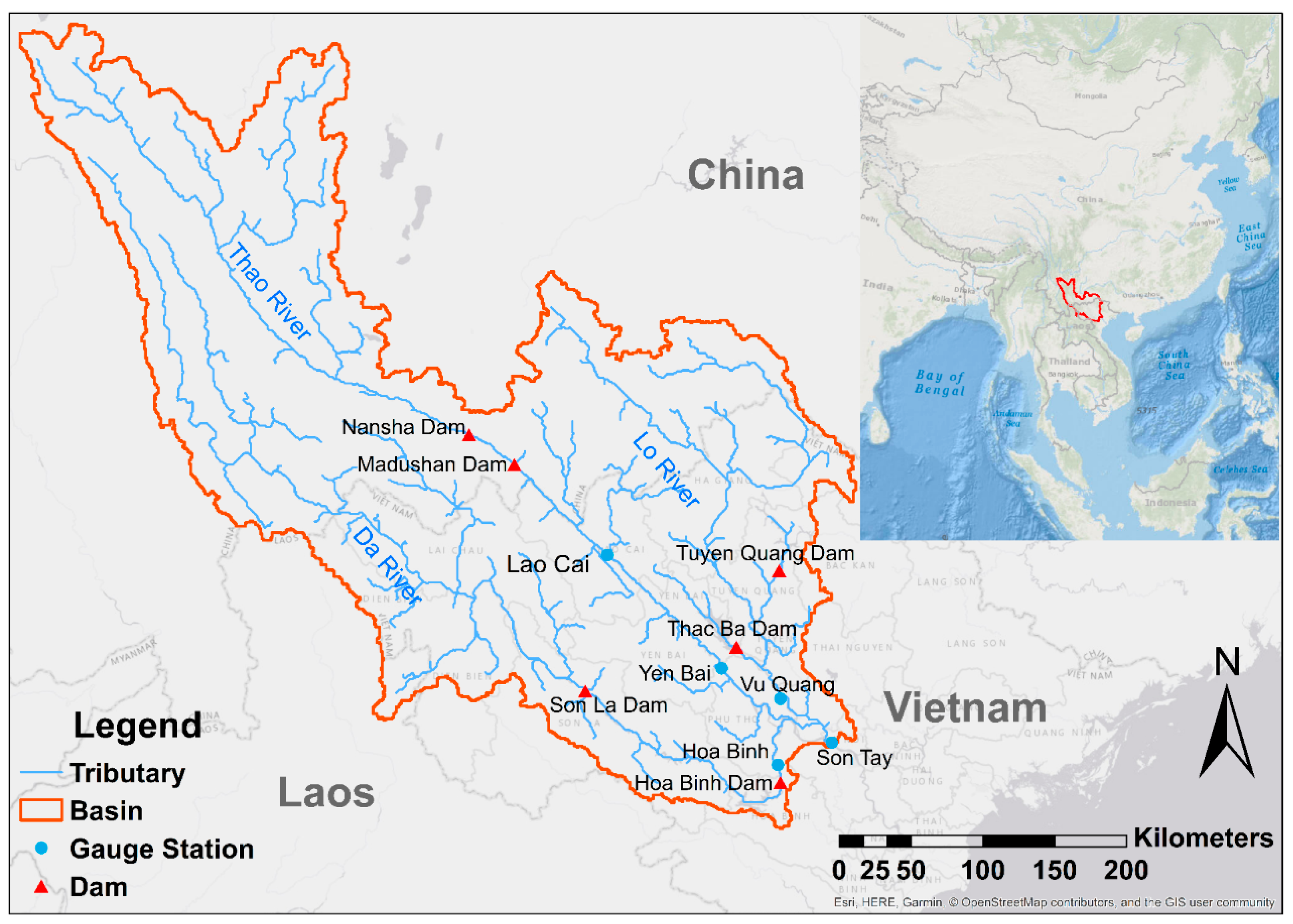
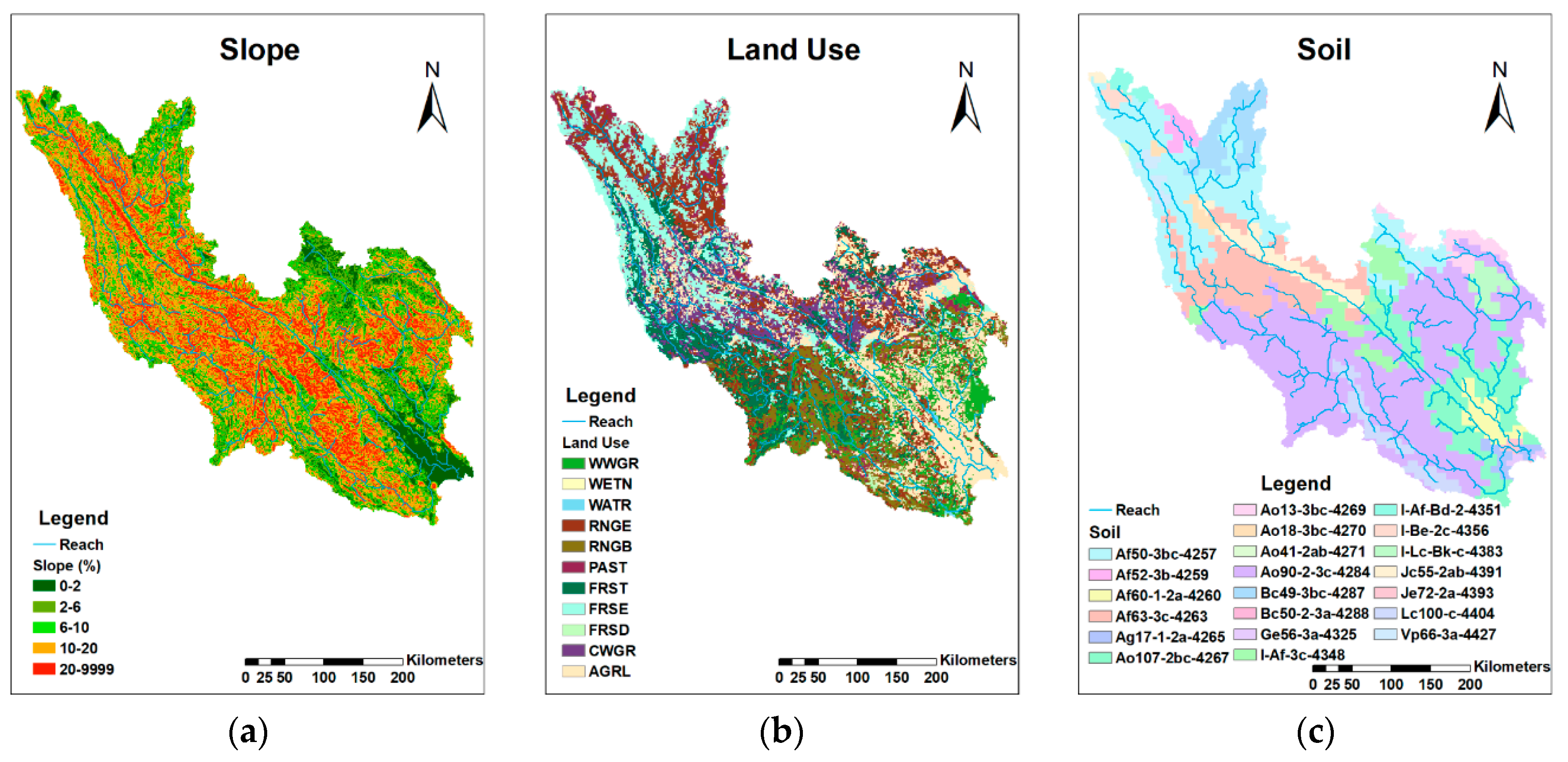
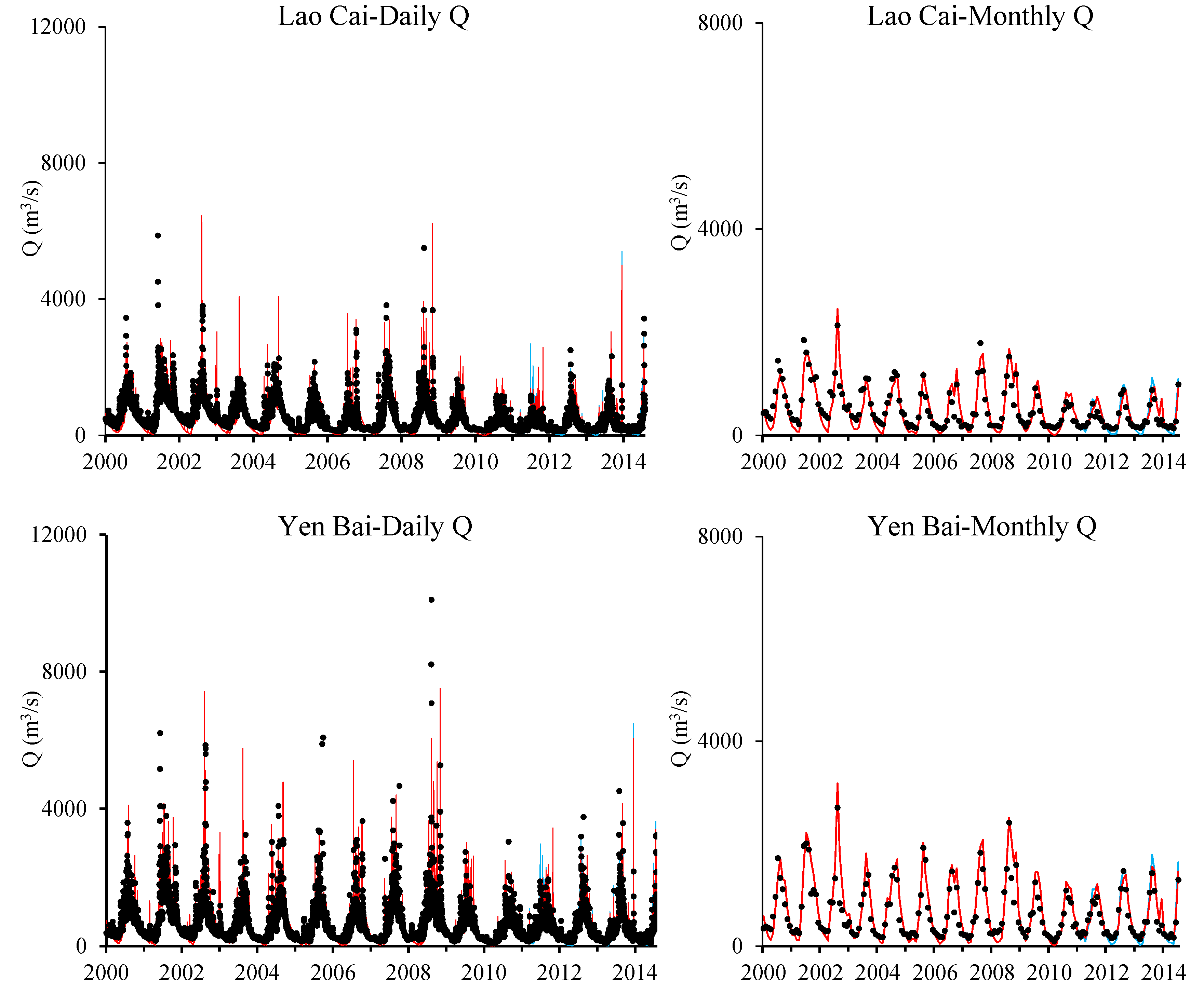

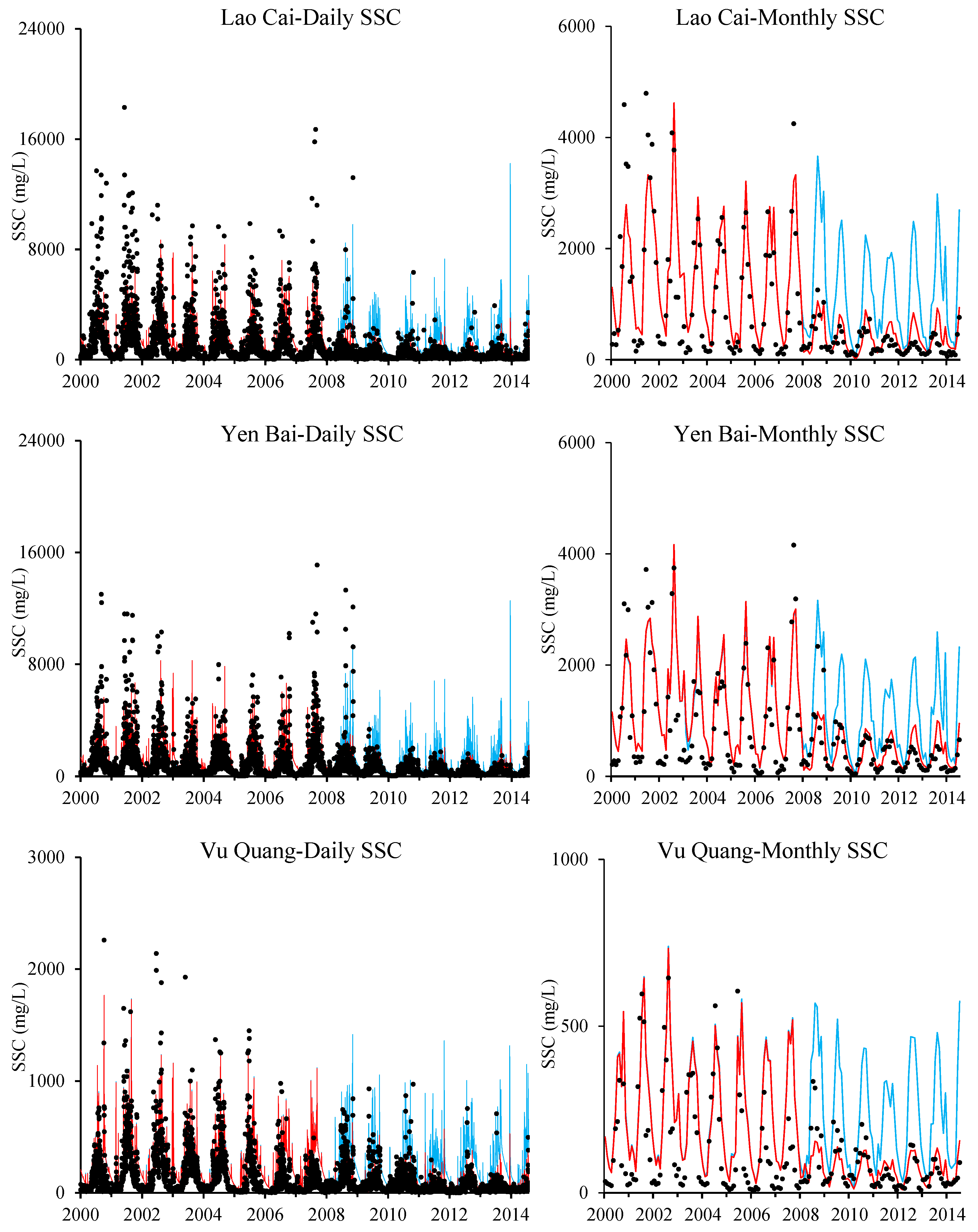
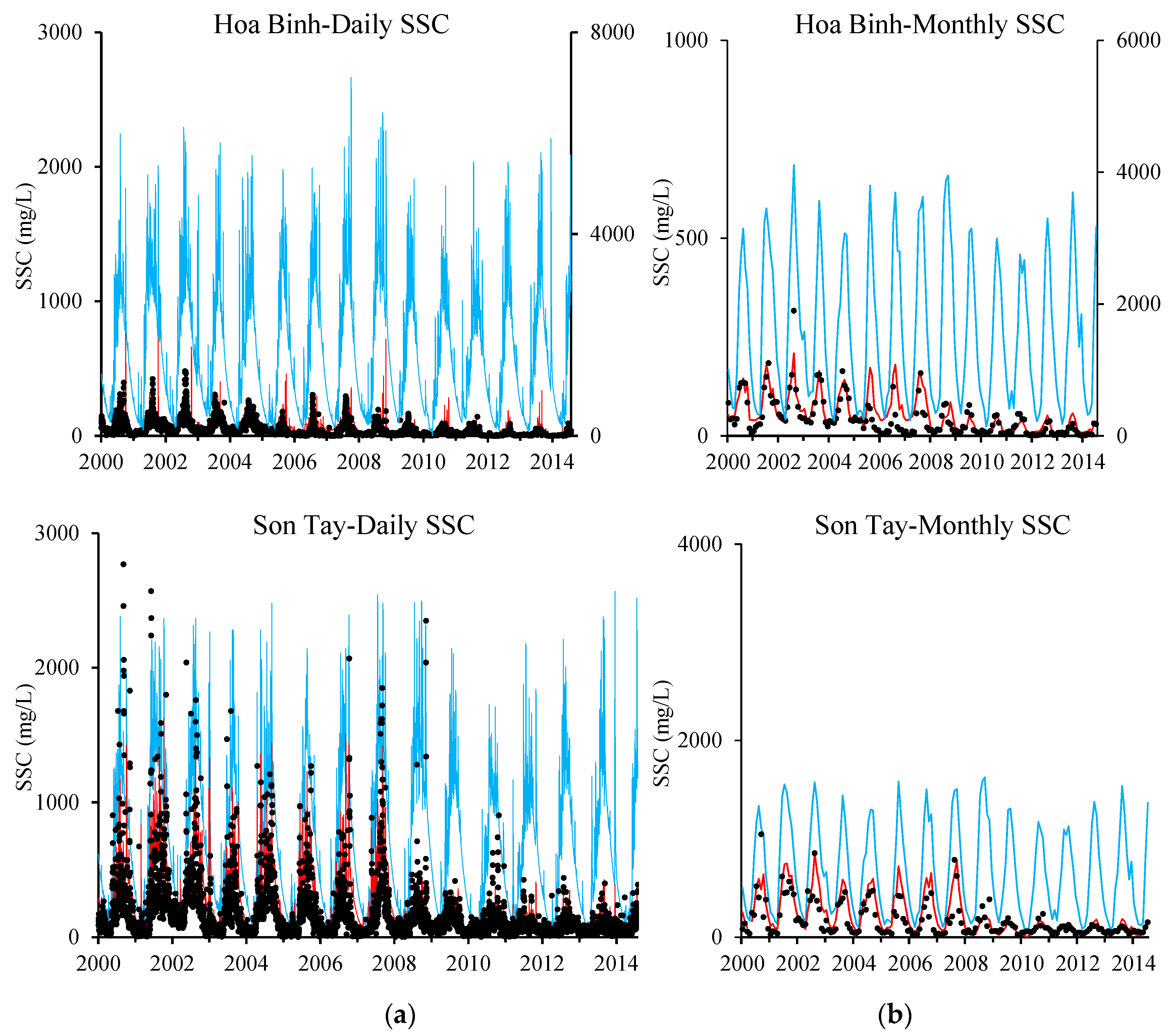
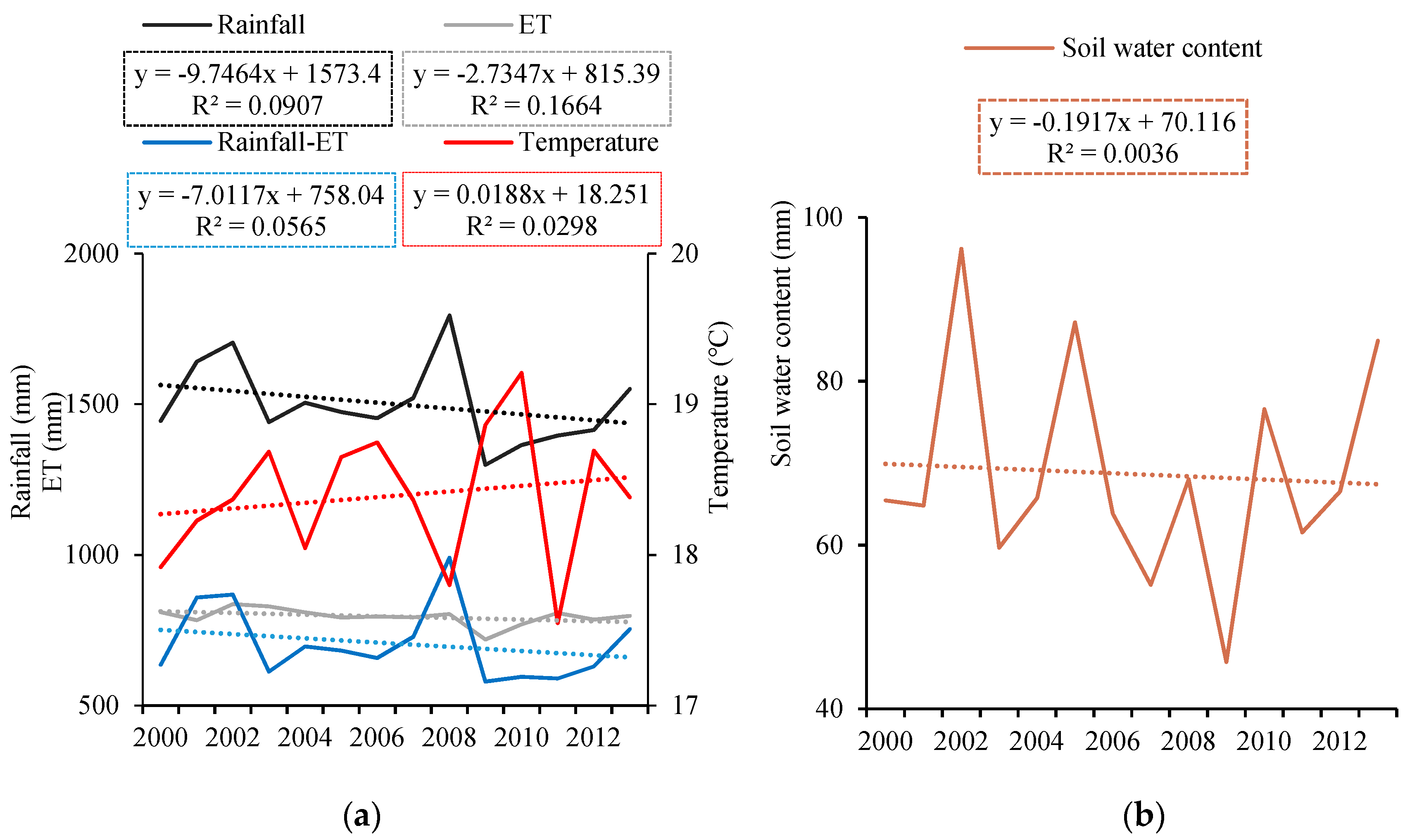
| Name (Basin) | Construction | Operation | Capacity (× 109 m3) | Mean Water Level (m) | Mean Annual Discharge (m3/s) | Maximum Discharge (m3/s) |
|---|---|---|---|---|---|---|
| Nansha (Thao) | February 2006 | November 2007 | 0.26 | 267 | 261 | – |
| Madushan (Thao) | December 2008 | December 2010 | 0.55 | 217 | 302 | – |
| Hoa Binh (Da) | 1980 | 1989 | 9.50 | 115 | 1780 | 2400 |
| Son La (Da) | December 2005 | December 2010 | 9.26 | 215 | 1530 | 3438 |
| Thac Ba (Lo) | 1965 | October 1971 | 2.90 | 58 | 190 | 420 |
| Tuyen Quang (Lo) | December 2002 | March 2008 | 2.24 | 120 | 318 | 750 |
| Data Type | Resolution/Time Scale/Period | Source |
|---|---|---|
| Topography (DEM) | 1 × 1 km | Shuttle Radar Topography Mission (SRTM30 30 arc-sec, http://www2.jpl.nasa.gov/srtm) |
| Land cover | 1 × 1 km | Global Land Cover 2000 database (https://forobs.jrc.ec.europa.eu/products/glc2000/glc2000.php) |
| Soil types | 1 × 1 km | Harmonized World Soil Database (http://webarchive.iiasa.ac.at/Research/LUC) |
| Temperature | daily scale June 1998 to July 2014 | Climate Forecast System Reanalysis: Global Weather Data for SWAT (https://globalweather.tamu.edu/) |
| Precipitation | daily scale 0.25° × 0.25° June 1998 to December 2014 | Tropical Rainfall Measuring Mission (TRMM, https://pmm.nasa.gov/TRMM) |
| Discharge and suspended sediment concentration | 5 stations: Lao Cai, Yen Bai, Vu Quang, Hoa Binh, Son Tay daily scale June 2000 to December 2014 | Vietnam Ministry of Natural Resources and Environment (MONRE) |
| Performance Rating | NSE | PBIAS | |
|---|---|---|---|
| Q | SSC | ||
| Very good | 0.75 < NSE ≤ 1.00 | PBIAS < ±10 | PBIAS < ±15 |
| Good | 0.65 < NSE ≤ 0.75 | ±10 ≤ PBIAS < ±15 | ±15 ≤ PBIAS < ±30 |
| Satisfactory | 0.50 < NSE ≤ 0.65 | ±15 ≤ PBIAS < ±25 | ±30 ≤ PBIAS < ±55 |
| Unsatisfactory | NSE ≤ 0.50 | PBIAS ≥ ±25 | PBIAS ≥ ±55 |
| Parameter (Name in Equations) | Input File | Definition | Range | Calibrated Value |
|---|---|---|---|---|
| OV_N | .hru | Manning’s “n” value for overland flow | 0.01–30 | 0.4 |
| SLSUBBSN | .hru | Average slope length (m) | 10–150 | ×1.2 (relative change) |
| HRU_SLP | .hru | Average slope steepness (m/m) | – | ×0.8 |
| ESCO | .hru | Soil evaporation compensation factor | 0–1 | 0.7 |
| PRF (prf) | .BSN | Peak rate adjustment factor for sediment routing in the main channel | 0–2 | 1 |
| SPCON (Csp) | .BSN | Linear parameter for calculating the maximum amount of sediment that can be re-entrained during channel sediment routing | 0.0001–0.01 | 0.008 (Period 2000–2007) 0.002 (Period 2008–2014) |
| SPEXP (spexp) | BSN | Exponent parameter for calculating sediment re-entrained in channel sediment routing | 1–2 | 2 |
| ALPHA_BF | .gw | Baseflow alpha factor | 0–1 | 0.02 |
| GW_REVAP | .gw | Groundwater “revap” coefficient | 0.02–0.20 | 0.03 |
| REVAPMN | .gw | Threshold depth of water in the shallow aquifer for “revap” or percolation to the deep aquifer to occur | 0–1000 | 800 |
| RCHGR_DP | .gw | Deep aquifer percolation fraction | 0.0–1.0 | 0 |
| GWQMN | .gw | Threshold depth of water in the shallow aquifer required for return flow to occur | 0–5000 | 600 |
| GW_DELAY | .gw | Groundwater delay time | 0–500 | 16 |
| SOL_AWC | .sol | Available water capacity of the soil layer | 0–1 | ×1.2 |
| USLE_K (KUSLE) | .sol | USLE equation soil erodibility (K) factor | 0–0.65 | Thao River basin 0.3 Lo River basin 0.2 Da River basin 0.3 |
| CH_COV1 (Kch) | .rte | The channel erodibility factor | −0.05–0.6 | Thao River basin: upstream Yen Bai: 0.23; Yen Bai-Son Tay: 0.013 Lo River basin 0.013 Da River basin 0.026 |
| CH_COV2 (Cch) | .rte | Channel cover factor | −0.001–1 | 1 |
| CH_N2 | .rte | Manning’s “n” value for the main channel | −0.01–0.3 | 0.05 |
| USLE_P (PUSLE) | .mgt | USLE equation agricultural practice factor | 0–1 | Thao River basin 0.7(agriculture) Lo River basin 0.4(agriculture) Da River basin 0.7(agriculture) |
| FILTERW | .mgt | Width of edge-of-field filter strip | 0–100 | Thao River basin 0 Lo River basin 25 Da River basin 0 |
| CN2 | .mgt | Initial SCS runoff curve number | 35–98 | ×0.9 (Relative change) |
| CH_N1 | .sub | Manning’s “n” value for the tributary channels | 0.01–30 | 1 |
| Constituent | Scale | Statistics | Lao Cai | Yen Bai | Vu Quang | Hoa Binh | Son Tay |
|---|---|---|---|---|---|---|---|
| Q (m3/s) | Daily | NSE | 0.44 | 0.35 | 0.38 | 0.49 | 0.61 |
| R2 | 0.57 | 0.52 | 0.45 | 0.53 | 0.64 | ||
| PBIAS | 2.8 | −11.2 | 21.2 | 18.1 | 6.0 | ||
| p-value | <0.01 | <0.01 | <0.01 | <0.01 | <0.01 | ||
| Monthly | NSE | 0.78 | 0.78 | 0.58 | 0.70 | 0.85 | |
| R2 | 0.82 | 0.88 | 0.65 | 0.77 | 0.86 | ||
| PBIAS | 2.8 | −11.0 | 21.3 | 17.9 | 5.9 | ||
| p-value | <0.01 | <0.01 | <0.01 | <0.01 | <0.01 | ||
| SSC (mg/L) | Daily | NSE | 0.31 | 0.23 | 0.02 | 0.10 | 0.19 |
| R2 | 0.34 | 0.30 | 0.29 | 0.36 | 0.34 | ||
| PBIAS | −21.4 | −28.7 | −46.5 | −26.3 | −28.0 | ||
| p-value | <0.01 | <0.01 | <0.01 | <0.01 | <0.01 | ||
| Monthly | NSE | 0.70 | 0.64 | 0.24 | 0.59 | 0.52 | |
| R2 | 0.73 | 0.71 | 0.55 | 0.67 | 0.70 | ||
| PBIAS | −21.5 | −27.3 | −46.8 | −26.5 | −29.5 | ||
| p-value | <0.01 | <0.01 | <0.01 | <0.01 | <0.01 |
| Q (m3 s−1) | Lao Cai | Yen Bai | Vu Quang | Hoa Binh | Son Tay | |||||
|---|---|---|---|---|---|---|---|---|---|---|
| NC* | AC* | NC* | AC* | NC* | AC* | NC* | AC* | NC* | AC* | |
| 2000 | 551 | 551 | 757 | 757 | 694 | 694 | 1318 | 1370 | 2910 | 2963 |
| 2001 | 778 | 778 | 1013 | 1013 | 803 | 803 | 1645 | 1613 | 3656 | 3624 |
| 2002 | 741 | 741 | 971 | 971 | 733 | 733 | 1687 | 1688 | 3489 | 3491 |
| 2003 | 796 | 796 | 1029 | 1029 | 794 | 794 | 1677 | 1619 | 3696 | 3637 |
| 2004 | 520 | 520 | 745 | 745 | 670 | 670 | 1373 | 1364 | 2936 | 2928 |
| 2005 | 405 | 405 | 644 | 644 | 717 | 717 | 1217 | 1198 | 2713 | 2694 |
| 2006 | 476 | 476 | 666 | 666 | 651 | 651 | 1455 | 1456 | 2920 | 2921 |
| 2007 | 605 | 605 | 793 | 793 | 675 | 675 | 1521 | 1523 | 3123 | 3125 |
| 2008 | 693 | 693 | 995 | 995 | 975 | 1006 | 1810 | 1774 | 4019 | 4015 |
| 2009 | 406 | 406 | 623 | 623 | 722 | 763 | 1240 | 1391 | 2736 | 2928 |
| 2010 | 348 | 348 | 516 | 516 | 567 | 567 | 1110 | 849 | 2304 | 2043 |
| 2011 | 365 | 349 | 574 | 557 | 654 | 656 | 1221 | 1034 | 2603 | 2401 |
| 2012 | 351 | 352 | 566 | 568 | 723 | 717 | 1203 | 1093 | 2669 | 2556 |
| 2013 | 420 | 420 | 646 | 645 | 763 | 760 | 1452 | 1101 | 3066 | 2712 |
| 2000–2007 | 609 | 609 | 827 | 827 | 717 | 717 | 1487 | 1479 | 3180 | 3173 |
| 2008–2013 | 430 | 428 | 653 | 651 | 734 | 745 | 1339 | 1207 | 2900 | 2776 |
| Tendency 2000–2013 (m3 s−1 year−1) (related R**) | −27.4 (0.70) | −27.7 (0.70) | −28.5 (0.66) | −28.8 (0.66) | −2.7 (0.12) | −2.2 (0.09) | −22.2 (0.43) | −40.8 (0.62) | −51.5 (0.44) | −69.9 (0.54) |
| Tendency 2008–2013 (m3 s−1 year−1) (related R**) | −43.1 (0.61) | −43.5 (0.61) | −53.1 (0.57) | −53.5 (0.57) | −27.7 (0.38) | −36.6 (0.46) | −51.1 (0.37) | −116.3 (0.66) | −133.3 (0.42) | −207.8 (0.57) |
| Impacts of climate and dams | 30% | 21% | −4% | 18% | 13% | |||||
| Impacts of climate | 29% | 21% | −2% | 10% | 9% | |||||
| Impacts of dams | 0.4% | 0.3% | −2% | 8% | 4% | |||||
| SSC (mg/L) | Lao Cai | Yen Bai | Vu Quang | Hoa Binh | Son Tay | |||||
|---|---|---|---|---|---|---|---|---|---|---|
| NC* | AC* | NC* | AC* | NC* | AC* | NC* | AC* | NC* | AC* | |
| 2000 | 1435 | 1435 | 1281 | 1294 | 241 | 238 | 1549 | 80 | 682 | 321 |
| 2001 | 1860 | 1860 | 1660 | 1671 | 279 | 276 | 1809 | 90 | 830 | 396 |
| 2002 | 1815 | 1815 | 1669 | 1686 | 287 | 283 | 1836 | 88 | 780 | 362 |
| 2003 | 1915 | 1915 | 1714 | 1726 | 277 | 273 | 1852 | 90 | 848 | 400 |
| 2004 | 1383 | 1383 | 1244 | 1257 | 221 | 216 | 1586 | 76 | 684 | 307 |
| 2005 | 1196 | 1196 | 1141 | 1166 | 236 | 231 | 1446 | 71 | 624 | 296 |
| 2006 | 1308 | 1308 | 1151 | 1167 | 225 | 222 | 1636 | 80 | 679 | 289 |
| 2007 | 1498 | 1498 | 1338 | 1347 | 246 | 244 | 1717 | 84 | 731 | 320 |
| 2008 | 1727 | 511 | 1512 | 576 | 286 | 94 | 1916 | 33 | 800 | 107 |
| 2009 | 1206 | 360 | 1068 | 438 | 224 | 67 | 1486 | 22 | 626 | 77 |
| 2010 | 1018 | 342 | 983 | 385 | 208 | 65 | 1394 | 19 | 554 | 77 |
| 2011 | 1166 | 388 | 1028 | 428 | 208 | 64 | 1455 | 18 | 612 | 75 |
| 2012 | 1085 | 381 | 1005 | 429 | 240 | 69 | 1384 | 20 | 592 | 78 |
| 2013 | 1243 | 409 | 1140 | 471 | 227 | 66 | 1597 | 22 | 655 | 83 |
| 2000–2007 | 1551 | 1551 | 1400 | 1414 | 251 | 248 | 1679 | 83 | 732 | 336 |
| 2008–2013 | 1241 | 398 | 1122 | 455 | 232 | 71 | 1539 | 23 | 640 | 83 |
| Tendency 2000–2013 (mg L−1 year−1) (related R**) | −48.9 (0.68) | −132.9 (0.89) | −42.9 (0.69) | −111.5 (0.89) | −3.5 (0.53) | −19.9 (0.90) | −21.3 (0.49) | −6.7 (0.89) | −13.7 (0.62) | −28.9 (0.90) |
| Tendency 2008–2013 (mg L−1 year−1) (related R**) | −75.3 (0.56) | −11.5 (0.36) | −57.2 (0.54) | −14.5 (0.41) | −7.0 (0.45) | −3.7 (0.62) | −52.6 (0.49) | −1.7 (0.58) | −22.1 (0.48) | −3.5 (0.53) |
| Impacts of climate and dams | 74% | 68% | 72% | 99% | 89% | |||||
| Impacts of climate | 20% | 20% | 8% | 8% | 13% | |||||
| Impacts of dams | 54% | 48% | 64% | 90% | 76% | |||||
© 2019 by the authors. Licensee MDPI, Basel, Switzerland. This article is an open access article distributed under the terms and conditions of the Creative Commons Attribution (CC BY) license (http://creativecommons.org/licenses/by/4.0/).
Share and Cite
Wei, X.; Sauvage, S.; Le, T.P.Q.; Ouillon, S.; Orange, D.; Vinh, V.D.; Sanchez-Perez, J.-M. A Modeling Approach to Diagnose the Impacts of Global Changes on Discharge and Suspended Sediment Concentration within the Red River Basin. Water 2019, 11, 958. https://doi.org/10.3390/w11050958
Wei X, Sauvage S, Le TPQ, Ouillon S, Orange D, Vinh VD, Sanchez-Perez J-M. A Modeling Approach to Diagnose the Impacts of Global Changes on Discharge and Suspended Sediment Concentration within the Red River Basin. Water. 2019; 11(5):958. https://doi.org/10.3390/w11050958
Chicago/Turabian StyleWei, Xi, Sabine Sauvage, Thi Phuong Quynh Le, Sylvain Ouillon, Didier Orange, Vu Duy Vinh, and José-Miguel Sanchez-Perez. 2019. "A Modeling Approach to Diagnose the Impacts of Global Changes on Discharge and Suspended Sediment Concentration within the Red River Basin" Water 11, no. 5: 958. https://doi.org/10.3390/w11050958
APA StyleWei, X., Sauvage, S., Le, T. P. Q., Ouillon, S., Orange, D., Vinh, V. D., & Sanchez-Perez, J.-M. (2019). A Modeling Approach to Diagnose the Impacts of Global Changes on Discharge and Suspended Sediment Concentration within the Red River Basin. Water, 11(5), 958. https://doi.org/10.3390/w11050958









